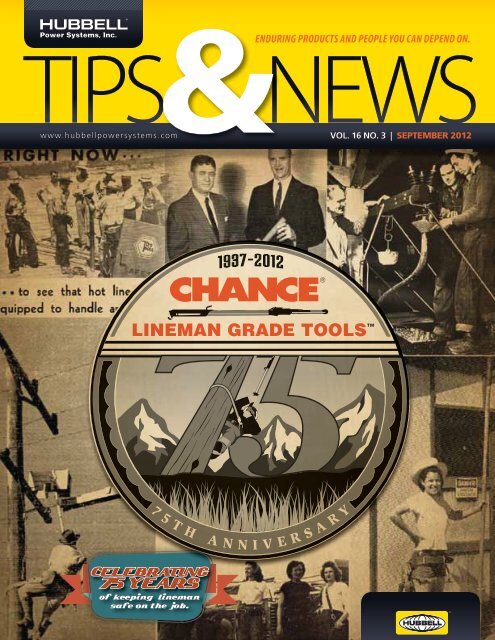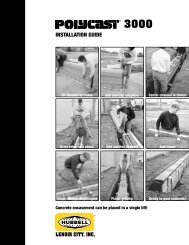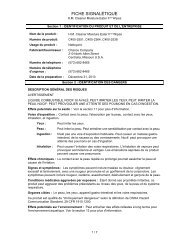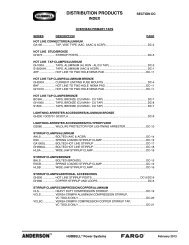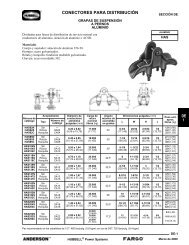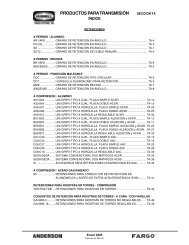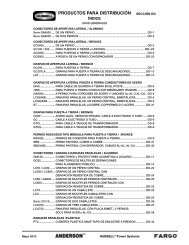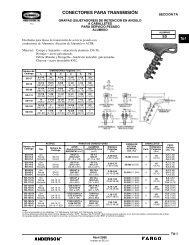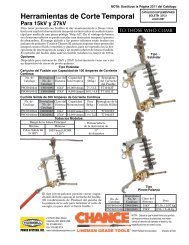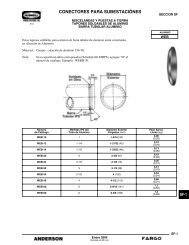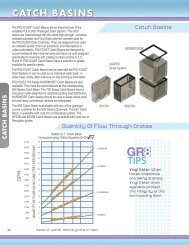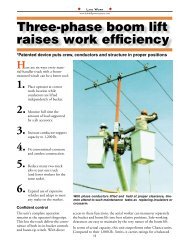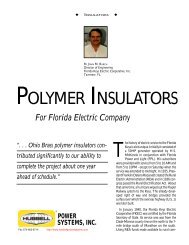75 YEARS - Hubbell Power Systems
75 YEARS - Hubbell Power Systems
75 YEARS - Hubbell Power Systems
Create successful ePaper yourself
Turn your PDF publications into a flip-book with our unique Google optimized e-Paper software.
TIPS &NEWS<br />
www.hubbellpowersystems.com<br />
CELEBRATING<br />
<strong>75</strong> <strong>YEARS</strong><br />
of keeping lineman<br />
safe on the job.<br />
ENDURING PRODUCTS AND PEOPLE YOU CAN DEPEND ON.<br />
VOL. 16 NO. 3 | SEPTEMBER 2012
2<br />
C O M M U N I C A T I O N S<br />
H U B B E L L<br />
OUTSIDE PLANT<br />
QUALITY • INNOVATION • CUSTOMER SERVICE<br />
<strong>Hubbell</strong> <strong>Power</strong> <strong>Systems</strong> supplies<br />
products to meet your outside plant,<br />
aerial and burial needs.<br />
• Aerial Pole Line Hardware<br />
• Anchoring <strong>Systems</strong><br />
• Deadends and Connectors<br />
• Polymer Concrete Enclosures and Pads<br />
Chance ® Anderson Fargo ®<br />
Quazite ® <strong>Hubbell</strong> ®
<strong>Power</strong>ful<br />
Partnership.<br />
Together, we can make a difference.<br />
NEWS<br />
HPS Wadsworth, Ohio Supports<br />
United Way Day of Action<br />
Special thanks to Lisa Pelfrey, Barb<br />
Geimer, Mike Comber, Ed Nyszczy and<br />
Michael Hearne of <strong>Hubbell</strong> <strong>Power</strong> <strong>Systems</strong><br />
(HPS) in Wadsworth, Ohio, who<br />
recently participated in this year’s United<br />
Way Day of Action. Across America<br />
on Thursday, June 21, people of all<br />
ages, backgrounds and abilities donated their time and talent to help others. Last year,<br />
more than 258 communities across each of the 50 states and Puerto Rico hosted a Day of<br />
Action, benefitting more than 242,680 people! HPS’s volunteers took part by volunteering<br />
for a Kidney Foundation of Medina County local service project.<br />
Congratulations to Dick Erdel on 40 years<br />
of Service with HPS! We’ve been told that some<br />
of you know Dick better as Erdel the Turtle and<br />
fondly remember the 70s as the Erdel Years.<br />
For the rest, you know Dick as the Ringmster<br />
at our trade shows and our Mad Man– I mean<br />
Ad Man- for 39 years. It's been a great 40 years;<br />
thanks for all your hard work, Dick!<br />
Join <strong>Hubbell</strong> <strong>Power</strong> <strong>Systems</strong> in support of<br />
sustainable business practices. Sign up for<br />
electronic statements, electronic invoices,<br />
and ACH payments.<br />
SIMPLE. SECURE. SMART.<br />
“<strong>Hubbell</strong> is committed to reducing harmful<br />
impacts to the environment…<br />
Our efforts will afford the next generation<br />
a future of brighter tomorrows”<br />
– Tim <strong>Power</strong>s, Chairman,<br />
CEO & President<br />
<strong>Hubbell</strong> Incorporated<br />
Call us at 573-682-8508 or 573.682.8816<br />
and start making a difference today.<br />
SEPTEMBER<br />
10 – 13 Solar <strong>Power</strong> Int Orlando, FL<br />
11 – 14 ARTBA (Road & Trans Builders) Memphis, TN<br />
12 – 14 Transmission & Sub Symposium Univ TX, Arlington<br />
16 – 18 AREMA American Railway Eng Chicago, IL<br />
18 – 20 UPMG Louisville, KY<br />
24 – 28 Hands On Distributor Training Aiken, SC<br />
24 – 26 FTTH Dallas, TX<br />
25 – 27 DistribuTech, Brazil, Rio De Janeiro, Brazil<br />
29 – 30 WEFTEC (Water Equip) New Orleans, LA<br />
30 – Oct 2 UPMG Seattle, WA<br />
OCTOBER<br />
1 – 5 Finepoint Circuit Breaker Conf Pittsburgh, PA<br />
3 – 6 NCSEA St. Louis, MO<br />
10 – 13 Lineman’s Rodeo Overland Park, KS<br />
17 – 19 SCTE Cable Tec Orlando, FL<br />
18 – 20 ASCE Conference Quebec, Canada<br />
20 – 23 USMA Scottsdale, AZ<br />
29 – 30 ASPE Engineered Plumbing Charlotte, NC<br />
11 SCE&G Equipment Show Columbia, SC<br />
12 CEEUS Columbia, SC<br />
NOVEMBER<br />
14 – 15 Outside Plant Denver, CO<br />
Upcoming Shows<br />
3
4<br />
A rich history<br />
like no other...<br />
The first Ad Manager<br />
1939-1942<br />
Women lineman for Grand Valley<br />
Rural <strong>Power</strong> Lines, Inc<br />
1947 -1948<br />
1956-1957
2003-2007<br />
1956-1957<br />
CELEBRATING<br />
<strong>75</strong> <strong>YEARS</strong><br />
of keeping lineman<br />
safe on the job.<br />
1995-1996<br />
Christmas Card Contest<br />
1956-1957<br />
&<br />
TIPS NEWS<br />
ANNIVERSARY ISSUE<br />
1967 -1968<br />
Recognize this<br />
handsome<br />
man? It’s Ed West,<br />
our Test Lab<br />
Manager.<br />
19<strong>75</strong>-197 6 1977 -1979 1980-1983<br />
5
6<br />
Parkingstand Lightning<br />
Arrester 200 Amp 15 kV<br />
FEATURES:<br />
• Fully wrapped Metal Oxide Varistor (MOV) block<br />
modules ensure compliance with all requirements<br />
of IEEE Std. C62.11, including safe failure mode<br />
• Provides excellent protection against lightning or<br />
switching surges<br />
• Operating interface conforms to figure 5 of IEEE Std. 386<br />
• Fully shielded and submersible, either continuously or<br />
intermittently, to a depth of 6 feet (2m)<br />
• ID band and stamp on end cap provides clear<br />
identification of voltage specifications<br />
• 36 inch standard lead length; other lengths are available<br />
• Internal contact molded into conductive insert to fully<br />
seal the chambers<br />
• Stainless steel bracket resists rust and corrosion<br />
<strong>Hubbell</strong> has a policy of continuous product improvement. We reserve the<br />
right to change design and specifications without notice.<br />
©Copyright 2012 <strong>Hubbell</strong> Incorporated<br />
S U R G E P R O T E C T I O N<br />
Safety and Surge Protection–<br />
Wrapped Into One<br />
HUBBELL ® ELASTIMOLD ® COOPER ®<br />
215PLA03 167PSA03 3237686C03M<br />
215PLA06 167PSA06 3237686C06M<br />
215PLA09 ----- 3237686C09M<br />
215PLA10 167PSA10 3237686C10M<br />
215PLA12 167PSA12 3237686C12M<br />
©Copyright 2012 <strong>Hubbell</strong> Incorporated www.hubbellpowersystems.com e-mail:hpsliterature@hubbell.com
From the name you trust and brand you depend on . . .<br />
L I N E M A N G R A D E T O O L S TM<br />
• ASTM D120 • Colors: Yellow-under-Black, Red-under-Black<br />
For details on CHANCE ® Lineman Grade Gloves, contact your local <strong>Hubbell</strong><br />
<strong>Power</strong> <strong>Systems</strong> representative or check out Catalog Section 2650 on our web site.<br />
Ergonomic innovation. Timely solutions.<br />
Just a few of the reasons the industry turns to <strong>Hubbell</strong> <strong>Power</strong> <strong>Systems</strong> and the Chance brand.<br />
©Copyright 2012 <strong>Hubbell</strong> Incorporated www.hubbellpowersystems.com e-mail:hpsliterature@hubbell.com<br />
TO THOSE WHO CLIMB <br />
Contour-Cuff Gloves &<br />
Bell-Cuff Rubber Gloves<br />
CHANCE ® natural rubber insulating gloves by <strong>Hubbell</strong><br />
<strong>Power</strong> <strong>Systems</strong>. Our ergonomic design provides better<br />
flexibility and comfort without compromising safety.<br />
Available in three ASTM classes, and a full range of<br />
sizes. CHANCE gloves deliver the ultimate protection<br />
and comfort To Those Who Climb.<br />
• Classes 2, 3 & 4<br />
• Length available: 18”<br />
• Featuring our durable on-product label<br />
Natural rubber formula provides excellent flexibility<br />
and electrical insulation<br />
Oval-shaped fingers help provide “No-Dead-Spots”<br />
feel and better dexterity<br />
Straight fingers relative to palm help prevent fatigue<br />
to tendons in back of hands<br />
Straight wrist in natural rest poition helps avoid<br />
fatiguing forearms and hands<br />
• Classes 1 through 4<br />
• Length 14” through 18”<br />
• Sizes: 9, 9 1/2, 10, 10 1/2, 11, 12<br />
7
8<br />
The Guardian<br />
Mike Glueckert, Sr. is a Journeyman<br />
Lineman/Troubleshooter at<br />
Northwestern Energy in Helena,<br />
Montana. He is also the guardian of hundreds of<br />
antique line tools.<br />
Glueckert started collecting line tools when he was<br />
a young apprentice, more than 37 years ago. But,<br />
he did not get serious until the end of the 1990’s.<br />
“The OSHA regulations changed and utilities in<br />
the US had to dispose of all their wooden tools. I<br />
saw my supervisor cutting the wooden handles in<br />
half and I asked if I could take the rest of the tools<br />
home with me. He said yes and it became clear to<br />
me that I needed to preserve some of our past,”<br />
explains Glueckert.<br />
What do you have in your collection?<br />
Primarily I collect safety line tools, but I have a<br />
little bit of everything. I have a lot of line tools<br />
including saddles, clamps, and anything to do<br />
with transmission work. I have wooden tools and<br />
some of the very first, epoxy-glass sticks. I have old<br />
wooden insulator cradles and wooden link sticks.<br />
I'm not a big insulator collector, but I do have some<br />
rubber goods.”<br />
Most of my tools are Chance ® tools. Of course,<br />
before it was Chance it was Tips Tool Company<br />
(1918-1937). Our forefathers, started with Tips.<br />
And, some of the most popular tools in the<br />
collection are the Tips and Chance shotgun sticks.<br />
I have quite a few for transmission work, as well<br />
as six-footers and folding sticks. I have a number<br />
of different universal sticks with all the tips and a<br />
variety of tie heads.<br />
I also have my own, fully refurbished, 1959 hot stick<br />
trailer. It is a Chance trailer, filled with Chance tools.<br />
of Historic Line Tools<br />
What is the oldest thing you have in your<br />
collection?<br />
“I have some very old tool belts. They are<br />
homemade out of horse harness leather. I don’t<br />
know how old they are for sure, but I suppose they<br />
were made at the turn-of-the-century or early in<br />
the 1900s. As far as tools go, I have a large variety<br />
of Tips tools from the 1920s.”<br />
What do you think has changed the most<br />
over the years?<br />
“The basic tools haven’t changed much over the<br />
years, but there have been many modifications.<br />
Most of the changes were made because the<br />
hardware on the lines changed. Over the years,<br />
more large heavy tools have been developed for<br />
transmission work. These have been incorporated<br />
into the trade to accommodate the heavy string of<br />
bells, for example. Those are all fairly new tools.<br />
And, since the industry is reluctant to take lines out<br />
of service, we've been seeing more live line work<br />
and more bare hand work and all the tools that<br />
you need to do that work. One major change is the<br />
addition of electronic components to line tools.”<br />
What are some the strangest items that you<br />
have?<br />
“One of the most unique things is an old Tips Tool<br />
grounding chain. It is a braided copper chain the<br />
linemen would attach to ground--either the shield<br />
wire or a local ground. Then, they would pull the<br />
other end of the chain over the conductor with an<br />
old manila rope. So, it was just a copper chain lying<br />
over the conductor. There aren’t many of those<br />
around anymore.<br />
Also, I have some antique climbing hooks that<br />
the lineman wore. In the old days, the shank was
Learn more about our walk-in tool<br />
1951-1953<br />
trailers! Email hpsliterature@hubbell.com<br />
and request bulletin number 07-1201.<br />
19<strong>75</strong>-1976<br />
1947-1948<br />
1963<br />
on the outside of the leg, with a very<br />
small gaff on the inside. Back then,<br />
everyone wore tall boots and it wasn’t<br />
uncomfortable to have the support on<br />
the outside.”<br />
What are your future plans?<br />
“I will keep collecting these tools, but<br />
they don't belong to me. They belong to<br />
everyone. When I retire, I am going to<br />
put them someplace where all linemen<br />
can see and enjoy them.”<br />
2012<br />
9
10<br />
MISSION-CRITICAL<br />
PROTECTION<br />
HPS just concluded its 3-part webinar series<br />
detailing how Chance® cutouts provide<br />
mission-critical protection. Presented by<br />
Charles Worthington, Cutout Product<br />
Engineer, the presentation covered the<br />
three strengths of the Chance® cutouts:<br />
technology, experience, and quality.<br />
TECHNOLOGY<br />
• Synthetic fusetube liner delivers consistent arc<br />
quenching and longer life<br />
• Moisture excluded by sealed hardware via polymer<br />
overmounding and blind end fitting bolt holes<br />
EXPERIENCE<br />
• The OB insulator is the only design to employ timeproven<br />
durable, tracking-resistant ESP hydrophobic<br />
silicon-alloy rubber<br />
• Combined technological excellence from 50+ years of<br />
Chance cutouts and 30+ years of Ohio Brass insulators.<br />
QUALITY<br />
• Exceptional mechanical and electrical performance due<br />
to hardware crimping technology and chemical bonding<br />
technology at interface to polymer watershed<br />
• Withstands 250% of ANSI C29.13 for boiling water/<br />
steep wave tests<br />
• For corrosive areas, available with stainless-steel<br />
hardware and assist spring<br />
To receive the audio recording from the<br />
webinar, contact your territory manager.<br />
CUTOUT<br />
TECHNOLOGY | EXPERIENCE | QUALITY<br />
<strong>Hubbell</strong> has a policy of continuous product improvement. We reserve the right to change<br />
design and specifications without notice.<br />
©Copyright 2012 <strong>Hubbell</strong> Incorporated<br />
Printed in U.S.A.<br />
LINER AND SHELL<br />
Liner and shell epoxy-resin matrices form a<br />
chemical bond as the shell is wound over the<br />
uncured liner. This outperforms the mechanical<br />
bond of a fusetube with a bone fiber liner due<br />
to its high moisture content — illustrated by<br />
comparison photos after a thermal cycling test<br />
which simulates aging.<br />
FUSETUBE INTEGRITY<br />
BONE FIBER SYNTHETIC
New Side Load<br />
Quadrant Deadend<br />
For more information, contact your Territory Manager.<br />
<strong>Hubbell</strong> has a policy of continuous product improvement. We reserve the right to<br />
change design and specifications without notice.<br />
©Copyright 2012 <strong>Hubbell</strong> Incorporated<br />
Printed in U.S.A.<br />
19-2000 JUNE 2012<br />
Q U A D R A N T D E A D E N D<br />
PATENT PENDING<br />
SLQ48N: A Truly Unique Quadrant Clamp<br />
• Side loading conductor groove makes<br />
installation much quicker than conventional<br />
u-bolt style quadrant clamps.<br />
• Single 1/2” bolt allows for hand or hydraulic<br />
tool installations.<br />
• Spring loaded design holds keeper out of the<br />
way for easier conductor insertion.<br />
• For use with AAC, AAAC, & ACSR conductors.<br />
CATALOG<br />
NUMBER<br />
SLQ48N<br />
SLQ48S<br />
SLQ48C<br />
CLAMPING RANGE RECOMMENDED<br />
ACSR ALUM IN. (mm) TORQUE<br />
#6 (6/1)<br />
To<br />
2/0 (6/1)<br />
#4 (7 str) To<br />
2/0 (19 str)<br />
0.19 - .048<br />
(4.8-12.2)<br />
45 LB-FT<br />
(61 Nm)<br />
WRENCH<br />
FLAT<br />
3/4”<br />
(19 mm)<br />
www.hubbellpowersystems.com<br />
11
12<br />
Migrating to USCO ®<br />
Center Break V Switches:<br />
Problems and Solutions<br />
Technical Support Assists with<br />
Customer Switch Transition<br />
For over 25 years, Arizona Public Service<br />
(APS) used Cooper <strong>Power</strong> <strong>Systems</strong><br />
(formerly KPF) air break switches on<br />
our 69-kV overhead transmission<br />
lines. The switches are rated for 900-<br />
A, which worked well for us, since APS<br />
used 795 all-aluminum conductors on<br />
our transmission lines with the average<br />
amperage of about 850-A.<br />
www.hubbellpowersystems.com<br />
By Juan Gutierrez,<br />
Jr., Senior Engineer<br />
Arizona Public Service (APS)<br />
Yuma, Arizona<br />
In 2009, APS began designing lines that could<br />
carry more current. The operation/planners<br />
began looking for ways to carry more current<br />
over our existing lines; therefore, we started<br />
reconductoring existing lines with 795 ACSS<br />
conductors, which can carry currents as high as<br />
1500-A. Since the Cooper/ KPF air break switch<br />
was rated for 900-A, it was no longer an option.<br />
APS’ T&D Engineering and Standards (TDES)<br />
began looking at higher-rated air break switches<br />
and contacted a <strong>Hubbell</strong> representative for<br />
more information on the USCO® Center Break<br />
V Switch. This switch could withstand currents<br />
as high as 2000-A, but it was a different<br />
kind of switch and our APS construction and<br />
maintenance crews had reservations.
BUMPY TRANSITION<br />
As a trial, we bought and installed three<br />
of the new USCO switches. Although the<br />
construction crew members said they liked the<br />
switches, they complained that the switches<br />
were not packaged the way they wanted them<br />
to be nor were they comfortable with the<br />
installation instructions.<br />
Further, our old switch configuration included<br />
an interrupting bottle that dropped the<br />
parallel line charge on the lines for up to 40<br />
miles. Some of our people wanted to continue<br />
using the vacuum bottles. Others didn’t want<br />
to use the bottles. And some didn’t want the<br />
USCO switches at all.<br />
Another issue was training. Even though<br />
USCO/<strong>Hubbell</strong> <strong>Power</strong> <strong>Systems</strong> offered to train<br />
our crews on how to install the Center Break<br />
V Switches, our APS crews couldn’t work it<br />
into their busy schedule. Despite all this, APS<br />
decided to buy and install the USCO Center<br />
Break V switches, as our new standard on new<br />
and existing 795 ACSS lines.<br />
In the beginning of 2010, TDES began receiving<br />
reports of USCO switch failures in Yuma, AZ;<br />
problems included both vacuum bottle and<br />
switch operation failures. APS had purchased<br />
and installed 10 USCO switches in the area<br />
and, after an investigation, we discovered that<br />
each of the 10 switches had been installed<br />
in a different manner. It became very clear<br />
that the problems were due to lack of proper<br />
switch installation training.<br />
Pete Swales, Sales Representative for <strong>Hubbell</strong><br />
<strong>Power</strong> <strong>Systems</strong>, and Ron Chamblee, Production<br />
Supervisor for <strong>Hubbell</strong>’s USCO brand were<br />
immediately contacted for training assistance.<br />
Without delay, <strong>Hubbell</strong> started working with<br />
us to fix the problem. Although Ron was based<br />
out of Alabama, he said “If I have to jump on a<br />
plane tomorrow, I will.”<br />
TIPS &NEWS<br />
ANNIVERSARY ISSUE<br />
Working with TDES, Pete and Ron set up on-site<br />
training, in Yuma, to make sure that all USCO<br />
switches were properly installed and operated<br />
correctly.<br />
This training took place in the middle of the<br />
Arizona summer, when temperatures were hitting<br />
110 degrees Fahrenheit, every day. Ron came<br />
down twice and spent a week each time with the<br />
crews responsible for installing the switches. He<br />
even went up in a bucket with groups of crew<br />
members to make sure everyone really learned<br />
how to properly install the switches.<br />
While Ron was here in Arizona, we had the<br />
APS training department make an installation<br />
training video, which is currently available on<br />
our internal APS web site.<br />
13
14<br />
TIPS &NEWS<br />
ANNIVERSARY ISSUE<br />
TRAINING IS KEY<br />
This on-the-job training was warmly received by<br />
all the crews and they really appreciated Ron’s<br />
knowledge and training skills. Our crews were<br />
particularly impressed by the extent to which<br />
Ron endorsed the switch, a good indication of a<br />
quality product. Ron’s customer service didn’t end<br />
with his training. He passed out his business cards<br />
to the crews, with an invitation to call him with<br />
any questions or problems they might encounter.<br />
Several linemen have taken advantage of Ron’s<br />
offer, and he was able to resolve their issues over<br />
the phone.<br />
When the switches were not operating correctly,<br />
a lot of the crew members lost their confidence in<br />
the switch and no longer wanted them. But, after<br />
showing everyone how to properly install the USCO<br />
Center Break V switch, the crews don’t want to use<br />
anything else.<br />
After the training, complaints about the USCO<br />
switches dropped from eight or nine per week to<br />
zero.<br />
Migrating to USCO® Center Break V Switches<br />
STREAMLINE PURCHASING<br />
The support from <strong>Hubbell</strong> <strong>Power</strong> <strong>Systems</strong> didn’t<br />
end with on-site training. When we first began<br />
purchasing USCO switches, we bought two different<br />
models: a vertically stacked configuration and a<br />
delta configuration. One came with a 1.5-inch pipe<br />
(handle) and the other with a 2-inch pipe. TDES<br />
asked if USCO/<strong>Hubbell</strong> <strong>Power</strong> <strong>Systems</strong> could provide<br />
APS with only one size pipe for both configurations.<br />
<strong>Hubbell</strong> <strong>Power</strong> <strong>Systems</strong> confirmed that the 2-inch<br />
pipe would work for both switch configurations.<br />
This made standardization, purchasing, and<br />
shipping simpler and more efficient and, since then,<br />
we haven’t had any issues with receiving our orders.<br />
T&D Engineering and Standards has experienced<br />
many companies extolling the virtues of their<br />
customer service department, but this doesn’t mean<br />
they know what they’re talking about. Not once did<br />
Pete or Ron unduly praise <strong>Hubbell</strong>’s customer service<br />
department; they didn’t need to pat themselves<br />
on the back. They knew what needed to be done<br />
and, once it was completed, they started to work<br />
on a follow-up plan. <strong>Hubbell</strong> <strong>Power</strong> <strong>Systems</strong> gets an<br />
A+ and 100% from me, because of the continued<br />
technical and customer support on the USCO Center<br />
Break V switch.
CHANCE ® ANCHORS<br />
TRUE-SPEC ANCHORS<br />
To assure your trust in CHANCE® Anchors,<br />
we authenticate the steel we use in them.<br />
Look for our Standard Marks of Anchor Excellence.<br />
COMPLETE MATERIAL TRACEABILITY<br />
• Components are permanently stamped with unique numbers.<br />
• Assures you the steel meets the specs we demand from our suppliers.<br />
PRODUCTS INCLUDED:<br />
• PISA ® anchors and rods<br />
• Square Shaft lead sections and extensions<br />
• No-Wrench anchors<br />
For more details on CHANCE ® Anchors and Anchor Tools, contact your <strong>Hubbell</strong> <strong>Power</strong><br />
<strong>Systems</strong> representative or visit http://www.hubbellpowersystems.com/anchoring/<br />
©Copyright 2012 <strong>Hubbell</strong> Incorporated www.hubbellpowersystems.com e-mail:hpsliterature@hubbell.com<br />
15<br />
15
SPENT FUSE LINKS<br />
TiPS of the trade<br />
A used link has a story to tell<br />
Finding cutouts open, but no signs of trouble on<br />
the line, can be frustrating for line personnel. A link<br />
removed from an open cutout and visually examined<br />
is sometimes categorized as having “pulled apart.”<br />
In reality, the link may be spent because there was a<br />
fault and the link reacted to it. By looking for certain<br />
characteristics on activated Chance Type T, K, and Slo-<br />
Fast links, you can determine when links have operated<br />
and at what general current levels.<br />
FUSE CONSTRUCTION<br />
To analyze the remains of a fuse link, one must<br />
first know link construction. Different element<br />
materials, strain wires, solder and crimp<br />
connections, heater coils and solder junctions<br />
are all used in Chance fuse links to control<br />
operating speeds. Those performances<br />
are shown on published minimum melt<br />
and total clear curves (see Table 1 upper<br />
right).<br />
T LINK CONSTRUCTION<br />
T links, 1 through 3 amps have stainless<br />
steel elements mechanically crimped<br />
at the buttonhead and cable adapter.<br />
The 6 through 100 amp links have a similar<br />
construction except the stainless steel wire acts<br />
mainly as a load-bearing strain member.<br />
Current is carried primarily by a parallel pure tin<br />
element which is soldered to the exterior of the<br />
buttonhead and cable adapters at the crimps.<br />
16 www.hubbellpowersystems.com
STRAIN<br />
WIRE<br />
CRIMP<br />
BOTH<br />
ENDS<br />
SOLDER<br />
BOTH<br />
ENDS<br />
SMOOTH<br />
TIN<br />
ELEMENT<br />
140 and 200 amp T links have a heavy<br />
copper element which is soldered<br />
into the buttonhead at the top and<br />
mechanically crimped into the cable<br />
adapter at the bottom.<br />
K LINK CONSTRUCTION<br />
The 1 through 3 amp K links are<br />
constructed the same as T links. The 6<br />
through 100 amp K links have stainless<br />
steel strain wires to provide mechanical<br />
strength and copper alloy elements<br />
to carry current. These two wires are<br />
attached in parallel by crimps at the<br />
buttonhead and cable adapter (see<br />
Photograph 1). The 140 and 200 amp K<br />
links have large silver/copper elements<br />
which, unlike T links, are crimped<br />
both at the cable adapter and<br />
buttonhead (see Photograph 2).<br />
SLO-FAST LINK<br />
COPPER<br />
ELEMENT<br />
SOLDER<br />
CRIMP<br />
CONSTRUCTION<br />
Slo-Fast links have two sections<br />
(Photograph 3). The slow section<br />
has a current-carrying heater coil<br />
wrapped around an insulated strain<br />
pin. The two in parallel are crimped at<br />
one end in the buttonhead and at the<br />
other in a small copper tube. The fast<br />
section has a stainless steel strain wire<br />
and parallel copper element, similar<br />
to a K link. These two are crimped at<br />
one end in the cable adapter and at the<br />
other end in a small copper tube. The<br />
two crimped copper tubes are joined by<br />
a solder connection.<br />
GENERAL STRENGTH<br />
T, K, and Slo-Fast links are designed to<br />
withstand pull forces in excess of 20 lb.<br />
This is twice the ANSI requirement of<br />
10 lb. The actual withstand capabilities<br />
vary from fuse to fuse. Generally, larger<br />
links have greater capability, but type<br />
of construction is also a big factor.<br />
15 amp T link 140 amp T link Photograph 1<br />
Photograph 2<br />
FUSE OPERATION<br />
High level faults, 1,000 amps and up, are<br />
easy to recognize. The fuse’s auxiliary<br />
tube is nearly gone or totally destroyed,<br />
and the element is consumed. When<br />
faults are in the 500 to 1,000 amp<br />
range, the auxiliary tube will burst but<br />
remain intact. In such cases most of the<br />
element is consumed depending on the<br />
size of the fuse. Unlike high-level fault<br />
incidents, lowlevel faults are sometimes<br />
hard to accept as having occurred<br />
because of the limited damage. In a<br />
low-level fault the auxiliary tube is<br />
not damaged, and the element may<br />
be nearly whole. By knowing the<br />
characteristics of a fuse link’s remains<br />
after a low-current operation, one can<br />
recognize that a fault has occurred.<br />
These characteristics vary with the fuse<br />
type.<br />
Photograph 3<br />
STRAIN<br />
WIRE<br />
15 Amp K Link<br />
CRIMP<br />
BOTH<br />
ENDS<br />
COPPER<br />
ALLOY<br />
ELEMENT<br />
CRIMP<br />
BOTH<br />
ENDS<br />
140 Amp K Link<br />
SILVER<br />
COPPER<br />
ELEMENT<br />
T LINK LOW-LEVEL OPERATION<br />
T links, 1 through 100 amps, which<br />
have operated at low fault or<br />
overload currents, have auxiliary tubes<br />
(Photograph 4) that have not ruptured.<br />
The tin element will melt somewhere<br />
between the soldered connections.<br />
This transfers the full current to the<br />
stainless steel strain member, which in<br />
turn melts in its mid-section. After the<br />
interruption, the remaining tin element<br />
will have its original smooth surface.<br />
The element’s solder connections,<br />
and the strain member’s crimped<br />
connections will be undisturbed. In<br />
Photographs 5, 6 and 7 the auxiliary<br />
tubes did not rupture, the tin elements<br />
17
and stainless steel strain wires melted<br />
between connections, the remaining<br />
elements have smooth surfaces, and<br />
the connections are undisturbed. These<br />
are all signs of a normal fuse operation<br />
at low current. The 140 and 200 amp T<br />
links (see Photograph 8) have a solder<br />
connection at the buttonhead end. On<br />
low-level faults this connection will<br />
melt and pull out of the buttonhead.<br />
This type of operation is often<br />
mistakenly considered a “pull apart.”<br />
As long as buttonhead and element are<br />
well wetted with solder, this is a normal<br />
operation.<br />
T LINK PULL APART<br />
T links, 6 through 100 amps, which have<br />
been mechanically over stressed and<br />
pulled apart, will have a stretched tin<br />
element. The surface of the element<br />
will be rough and the element will be<br />
necked down where it pulled apart. The<br />
strain wire will either pull out of one of<br />
the crimps, recognized by the bend at<br />
that end of the wire, or will break off<br />
right at one of the crimps (Photograph<br />
9). T links, 1 through 3 amps, have only<br />
stainless steel elements. If they pull<br />
apart, they will have elements which<br />
pull out or break off like the strain<br />
wires. The 140 and 200 amp T links are<br />
strong enough that a pull apart (pulling<br />
out of the crimp or solder connection)<br />
is unlikely.<br />
K LINK LOW-LEVEL OPERATION<br />
“K” links that have operated at low<br />
fault currents (Photograph 10) will have<br />
auxiliary tubes that have not<br />
ruptured. Like T links, the strain wire<br />
and element will melt somewhere<br />
between the connections, and the<br />
crimps will be undisturbed. The amount<br />
of element and strain wire consumed<br />
will be somewhat proportional to the<br />
ratio of fault current to the fuse rating,<br />
i.e., a fault of 15 times the fuse rating<br />
will consume more element than one<br />
which is only three times the rating.<br />
18 www.hubbellpowersystems.com<br />
Photograph 4 —Whole LAuxiliary Tube<br />
Photograph 6—40 Amp T Link<br />
STRAIN WIRE BROKEN<br />
K LINK PULL APART<br />
K links, 6 through 100 amps, which have<br />
been mechanically over stressed and<br />
pulled apart will have strain wires which<br />
pull out of the crimp and/or break off<br />
right at the crimp the same as T links.<br />
The element, being much stronger than<br />
tin, will not neck down much. Once the<br />
strain wire gives way, the total stress is<br />
placed on the element. The element will<br />
break at its weakest point anywhere<br />
along its length, not necessarily at the<br />
crimp. K links, 1 through 3 amps, have<br />
Photograph 5—10 Amp T Link<br />
Photograph 7—65 Amp T Link<br />
These links were mechanically pulled apart at forces above 20 lbs.<br />
STRAIN WIRE PULLED OUT<br />
SOLDER MELTED<br />
STRETCHED ELEMENT<br />
ROUGH ELEMENT SURFACE<br />
(Fuse was operated at 22 amps, 15 kV)<br />
Photograph 8<br />
Photograph 9<br />
Photograph 10 —6 Amp K Link<br />
only stainless steel elements. If they pull<br />
apart, they will have elements which<br />
pull out or break off like the strain<br />
wires shown at right (Photograph 11).<br />
The 140 and 200 amp K links are of such<br />
strength that a pull apart is unlikely.<br />
SLO-FAST LINKS<br />
LOW-LEVEL OPERATION<br />
Slo-Fast links have two sections that can<br />
operate at currents of 500 amps and<br />
below. The “fast” section is
similar to a K link. The fuse operates<br />
when the fault current is to the right of<br />
the “knee” of the minimum melt curve<br />
(see Table II). In this mode of operation<br />
the element and strain wire will melt<br />
somewhere between the crimps. The<br />
crimped sections of the element, and<br />
strain wire will be undisturbed. The<br />
remains will look similar to the K link in<br />
Photograph 10 on page 14. A Slo-Fast<br />
link operating in the slow section as<br />
shown in Photograph 12 is sometimes<br />
mistakenly considered a “pull apart.”<br />
At fault or overload currents to the<br />
left of the knee of the minimum melt<br />
curve, the heater coil transmits enough<br />
heat to the solder junction to cause the<br />
solder to melt. Separation at this point<br />
(provided both crimp tubes are wetted<br />
with solder) is a normal operation.<br />
SLO-FAST LINKS - PULL APART<br />
When Slo-Fast fuse links are mechanically<br />
over stressed and pulled apart, they will<br />
separate in the lower (fast) section. This<br />
section is constructed similar to a K link.<br />
As shown in Photograph 13 below, the<br />
strain wire pulls out and the element<br />
breaks off a little way from the crimped<br />
connection.<br />
SUMMARY<br />
By knowing what to look for, you can<br />
spot the characteristics of a normal<br />
low-level fault interruption. When the<br />
auxiliary tube has not burst, look for<br />
the following signs: T links: Element and<br />
strain wire melt in mid-section. Strain<br />
wire crimps undisturbed. Smooth surface<br />
on remaining tin element. K links:<br />
Element and strain wire melt between<br />
crimps. Crimps undisturbed. Slo-Fast<br />
links: Element and strain wire melt<br />
between crimps. Crimps undisturbed.<br />
Separation at solder junction. Heater<br />
coil and strain pin intact.<br />
Photograph 11<br />
These links pulled apart at forces above 20 lb. The elements<br />
broke at the top crimp connection.<br />
Photograph 13—7.0 Amp Slo-Fast Link<br />
(This link was mechanically pulled apart at a force above 20 lbs.)<br />
Photograph 12<br />
Table II<br />
SOLDER MELTED<br />
19
®<br />
TIPS &NEWS<br />
<strong>Hubbell</strong> TIPS & NEWS is published to inform<br />
personnel of electric utilities and associated<br />
companies of new ideas and techniques in<br />
transmission and distribution practices. The<br />
magazine, under different titles and formats,<br />
has been published since 1932.<br />
Your suggestions, editorial or photographic<br />
contributions are invited and may be submitted<br />
to <strong>Hubbell</strong> TIPS & NEWS.<br />
©Copyright 2012 <strong>Hubbell</strong> Incorporated<br />
NOTE: We have a policy of continuous product improvement<br />
and reserve the right to change design and specifications<br />
without notice.<br />
UNITED STATES, CANADA & INTERNATIONAL<br />
210 N. Allen • Centralia, MO 65240<br />
Phone: 1-573-682-5521 • Fax: 1-573-682-8714<br />
E-mail: hpsliterature@hps.hubbell.com<br />
HUBBELL TIPS & NEWS<br />
210 N. Allen Street<br />
Centralia, MO 65240-1395 USA<br />
ADDRESS SERVICE REQUESTED<br />
MEXICO<br />
S.A. DE C.V. • Av. Insurgentes Sur # 1228, Piso 8<br />
Col. Tlacoquemecatl Del Valle • Mexico, D.F. 03200<br />
Phone: 52-55-9151-9999 • Fax: 52-55-9151-9988<br />
www.hubbellpowersystems.com<br />
A Look Back at Chance Tips Magazine<br />
Presorted Standard<br />
U.S. POSTAGE PAID<br />
Lawrence, KS<br />
Permit No. 116<br />
VOL. 16 NO. 3 | SEPTEMBER 2012


